Postojnska Jama
Postojna Cave, Höhle von Postojna, Adelsberger Grotte, Grotta di Postumia
Useful Information

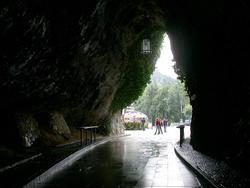

| Location: |
800 m northwest Postojna.
50 km south of Ljubljana. 2,4 km north of Postojnska Jama, 3 km north Postojna. Motorway E61 exit Postojna, towards the city, straight ahead through first roundabout, keep right at second roundabout. Turn left towards Postojna Cave, follow road for 1 km, parking lots on both sides of the road. Well signposted. (45.7826291, 14.2039505) |
| Open: |
APR to JUN daily 10, 11, 12, 14, 15, 16. JUL to AUG daily 9, 10, 10:30, 11, 11:30, 12, 12:30, 13, 14, 14:30, 15, 16, 17, 18. SEP daily 9-17, hourly. OCT daily 10, 11, 12, 13, 15, 16. NOV to MAR daily 10, 12, 15. [2024] |
| Fee: |
Adults EUR 29.90, Children (6-15) EUR 17.90, Children (0-5) EUR 1, Students (16-25) EUR 23.90. Combi with Vivarium and Expo Cave Karst: Adults EUR 29.90, Children (6-15) EUR 17.90, Children (0-5) EUR 1, Students (16-25) EUR 23.90. [2024] |
| Classification: |
 Karst Cave
cave system. Karst Cave
cave system.
 Cave Restaurant Cave Restaurant
 The Most Expensive Show Cave The Most Expensive Show Cave
|
| Light: |
 Electric Light Electric Light
|
| Dimension: | L=21,500 m, VR=138 m, A=450 m asl, T=8 °C. |
| Guided tours: |
L=5,250 m, 3,750 m by train, 1,500 m by foot, D=90 min. V=15,000 per day(!) V=800,000/a [2000] |
| Photography: | allowed |
| Accessibility: | no |
| Bibliography: |
Matjaz Kmecl (1990):
Die Höhle von Postojna,
Postojna, Postojnska jama, Turizem, 1990
|
| Address: |
Postojnska jama d.d., Jamska cesta 30, 6230 Postojna, Tel: +386-5-700-01-00.
E-mail: |
| As far as we know this information was accurate when it was published (see years in brackets), but may have changed since then. Please check rates and details directly with the companies in question if you need more recent info. |
|
History
| 1213 | first known-of visit. |
| 16th century | in a period of protestant renaissance, the visits of the cave reached a first maximum. |
| 1689 | described in Ehre des Herzugthums Crain by
 Johann Weichard Frh. von Valvasor,
a monography about central Slovenia. Johann Weichard Frh. von Valvasor,
a monography about central Slovenia.
|
| 1818 | installation of the first light, pathways and discovery of new parts of the cave, in preparation of the visit of Prince Ferdinand I. |
| 1819 | visit of Prince Ferdinand I, the heir to the Austrian throne. |
| 1824 | first dance events in the chamber now called Kongresna Dvorana (Congress Room). |
| 11-MAR-1857 | the opening of the new railroad Wien-Laibach-Triest (Vienna-Ljubljana-Trieste) increases the number of visitors drastically, cave visited by the imperial couple Franz Joseph and Elizabeth. |
| 16-JUN-1872 | first cave railroad built, carts pushed by servants. |
| 1884 | electric light installed, the second cave in the world with electric light. |
| 1901 | modernization of the electric light. |
| 1914 | gas fueled locomotive engines. |
| 1928 | modernization of the electric light. |
| 1959 | electric locomotive engines. |
| 1968 | building of todays’ trails. |
| 12-SEP-1965 | IV. International Speleological Congress held in the Kongresna Dvorana (Congress Room). |
Description

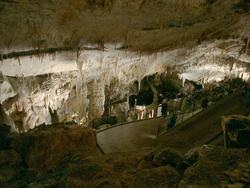

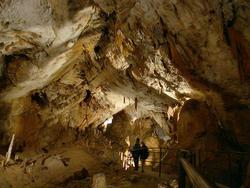

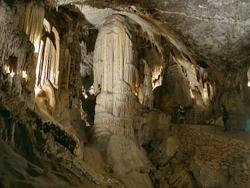

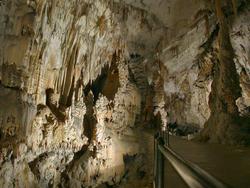

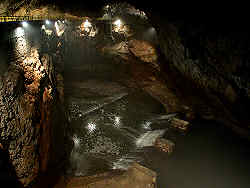
Postojnska Jama is one of the most famous caves of the world. One reason is the good accessibility of the cave: the natural entrance on the hillside is rather big, the cave itself is really huge and horizontal. So people visited the cave for many years, left their names on the walls and blackened the formations with their torches. It’s also the location at the road from Ljubljana to Trieste, which connected Vienna with the only harbour of the mostly landlocked Austro-Hungarian Empire. As a result there was traffic on the road through Postojna, and travellers making a stop visited the cave and probably spent the night in a local hotel. One of the first railroads of Austria connected Vienna and Trieste, with a railroad station at Postojna. And today it is located at the main motorway, which connects the cold northern European countries with the beaches of Croatia and Serbia. Tourists with RVs spend a last night in the coolness of the village, visit the cave and then go to the beach.
The entrance building of Postojna Cave was built in the 19th century. This was the time, when the growth of science made the whole area famous all over Europe. And the fact that Slovenia belonged to the Donaumonarchie (Austro-Hungarian Empire) allowed many people to travel freely to Postojna and visit the cave. From Bulgaria to Slovenia, from Czechia to Bosnia, one third of Europe was a single country, with people speaking the same language, having the same currency, and no borders. Even modern Europe is less comfortable for travelers, we have the Euro and Schengen, but the language barrier still exists.
As a result of the many visitors, the cave was equipped with carts in the 19th century, which were pulled by the guides. In the early 20th century replaced by mine trains, in the sixties a double track was built. And so the cave had a million visitors every year before the war in the early 1990 began. There was a sort of undeclared three-day-war in Slovenia, then the armies left without a single shot. Rumours said they paid the Serbs to go away. Slovenia left Yugoslavia and connected to Europe, was among the first bunch of countries which accepted the €. But it took years to regain the pre-war visitor numbers, because for some years it was not possible to go to the beaches because there were fights. And so the stopover of the tourists did not exist for many years. Until today the cave has not reached the pre-war visitor number, they are typically around 800,000 visitors per year.
Some say this cave is the oldest show cave of the world, which is based on an inscription which gives the year 1213. This is not valid though, because it just means that somebody visited the cave, but that’s not the definition of a show cave. There are hundreds of caves where people left inscriptions 2000 years ago in China, so if this was a show cave tour in 1213, it’s only the first in Europe, not the world. And another funny fact: the inscription was published by Volpi (1821) and Schaffenrath (1832), but it is lost and could not be found any more, despite massive search efforts. So actually, the famous date does not exist, at least it does not exist any more. They published a sort of drawing, which shows that the year is given in arabic numbers, which is a strong indication that it is fake anyway. At that time arabic numbers were not used, the people used the Roman numbers. So it was probably written by someone who didn’t know that, an incompetent fraudster, probably a cave guide who wanted to offer his guests something. Of course, it’s also possible that this number has a completely different meaning that we simply haven’t understood yet.
The important fact is something completely different: the country was the first where karst and caves were described.
The very first description is from
 Johann Weichard Frh. von Valvasor
in his book Die Ehre Deß Hertzogthums Crain (The honour of the Duchy of Carniola) from the 17th century.
Scholars, travelers and others began to visit the cave, and several of those visitors wrote descriptions and spread the word.
The locals earned good money with the cave, so they invested in infrastructure, inside and outside.
And finally, there were numerous congenial cave administrators who developed the cave for tourism and made the cave well known all over the world.
Johann Weichard Frh. von Valvasor
in his book Die Ehre Deß Hertzogthums Crain (The honour of the Duchy of Carniola) from the 17th century.
Scholars, travelers and others began to visit the cave, and several of those visitors wrote descriptions and spread the word.
The locals earned good money with the cave, so they invested in infrastructure, inside and outside.
And finally, there were numerous congenial cave administrators who developed the cave for tourism and made the cave well known all over the world.
But the cave has a long history and was used for many other purposes. It was used as storage room, as hideout, as bunker, and the Germans used it as a fuel depot during World War II. When the fuel was destroyed by partisans, the explosion and the fire, which burned for seven days, destroyed also a huge passage of the cave. The partisans were guided by a former cave guide, entered through Crna Jama, and used the artificial tunnel dug by the Italians to enter Postojna from behind. The Italians took all cave maps with them when they left, so the Germans did not know about this rear entrance and did not guard it. Today this tunnel is used for an alternative cave tour which combines Postojna and Crna jama.
While the guides still tell the horror story of the burning cave and the fuel of the ugly Germans, the first part of the cave, several hundred meters, is actually black and dirty from visitors of the last centuries. The visitors used candles and torches, which produce soot, and due to the high number of visitors, the pollution was also considerable. The visitors wrote their names on the walls, to tell anyone they were here, a behavior which is today considered very impolite, a sort of vandalism. But a few hundred years ago this was quite normal, nobody thought about protecting caves. And the former vandalism in the cave is now a field of research for historians, as several famous people have left their names on the walls.
Today the visitors traverse this area very fast on the cave train, which takes them about 2.5 km into the cave, where the actual tours take place. The visit starts at the entrance station of the cave railway, which is underground, behind the historic cave entrance building. The train passes through an artificial tunnel and reaches the main passage. The double tracks, which were built in 1964, follow this passage, and sometimes the train meets another train which leaves the cave. The first chamber of the ride is the Gothic Hall, with a rich decoration of stalactites and stalagmites. The next chamber which was used as Ballroom has bombastic glass lamps, and is used for functions until today. The most spectacular point, however, is when the train passes through the base of a huge stalagmite through which a tunnel has been built.
And the cave is so big, it has several other human installations beneath the train: a cave restaurant, a concert hall for more than 10.000 people, and the cave post office. There is also a huge aquarium showing olms (Proteus anguinus), which was removed after the Speleobiological Station was created. However, the visitors were disappointed, and finally the cave administration built a new aquarium which is quite huge. The historic pool built of marble still exists, but is not in use any more.
The tour starts at the end of the tracks, visitors, sometimes of two subsequent trains, meet at the huge plattform, where guides wait with a sign which language they speak. All tours offer Slovenian-, English-, German- and Italian-speaking tour guides, which is quite sectacular. Visitors speaking other languages can rent an audioguide. Then the tours start up the Great Mountain, a sort of underground hill which is also called Kalvarienberg (Calvary), a name which originated from the Austro-Hungarian times, and was quite popular in Slovenia. Actually, any cave has a Calvary in this country. When you have crossed the hilltop, the trail goes down in serpentines to the Russian Bridge, on the other the passage called Beautiful Caves follows. It has numerous spectacular speleothems, not only stalactites and stalagmites, but also rimstone pools, cave lakes with calcite crystals, which reflects in the names Spaghetti, White Hall and Red Hall. At the end of the passage, the tour path leads down to a lower passage which leads back to the Russian Bridge. Here is the Brilliant Passage, where the most famous stalagmite and symbol of Postojna Cave stands, the Brilliant. This is a strange white stalagmite which is rather slender, but is thicker at the top and thus looks like a bat. After crossing under the huge bridge, the aquarium containing human fish and then the Concert Hall are reached. The tour ends at the underground post office, café, and souvenir shop where the visitors wait for the next train.
We have one more advice and one recommendation.
The advice is: take a fleece and a windbreaker into the cave, the train ride gets very cold otherwise.
And the recommendation is, visit the nearby
 Vivarium
and the
Vivarium
and the
 Expo Cave Karst.
The first explains the cave biology and has numerous living true cave animals, which is really strange.
It is located inside a historic cave entrance which shows inscription by cave visitors for centuries.
And the second is a new museum about the development of the cave.
It explains the geology as well as the spectaculöar karst features in the area.
And it has an impressive exhibition on the development of the show cave, with historic engravings and photographs.
There is a combo ticket for all three.
Expo Cave Karst.
The first explains the cave biology and has numerous living true cave animals, which is really strange.
It is located inside a historic cave entrance which shows inscription by cave visitors for centuries.
And the second is a new museum about the development of the cave.
It explains the geology as well as the spectaculöar karst features in the area.
And it has an impressive exhibition on the development of the show cave, with historic engravings and photographs.
There is a combo ticket for all three.
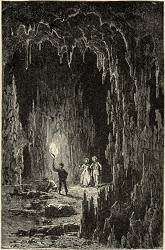










- More on showcaves.com
 Member of the International Show Caves Association (ISCA)
Member of the International Show Caves Association (ISCA) First Caves with Electric Light
First Caves with Electric Light Crater Names on Asteroid Ida
Crater Names on Asteroid Ida Cave Visits By Tram.
Cave Visits By Tram. The Most Expensive Show Cave
The Most Expensive Show Cave
 Search DuckDuckGo for "Postojnska Jama"
Search DuckDuckGo for "Postojnska Jama" Google Earth Placemark
Google Earth Placemark OpenStreetMap
OpenStreetMap Postojna Cave - Wikipedia (visited: 09-FEB-2024)
Postojna Cave - Wikipedia (visited: 09-FEB-2024) Postojna Cave, official website (visited: 13-AUG-2020)
Postojna Cave, official website (visited: 13-AUG-2020) (visited: 22-JAN-2023)
(visited: 22-JAN-2023) Index
Index Hierarchical
Hierarchical Countries
Countries Maps
Maps